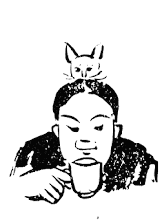文学是如何“再 现”“现实”的?
五十多年前,古典学者奥尔巴赫从纳粹德国逃命到了土耳其,以“历史”为纲写了本大书,回顾和分析自古希腊以来人们如何用文学 来再现现实,把这个事儿在西方的情形说了个透。从此以后,西方再没有人觉得有能力(一开始是这样)或者“屑于”(后来是这样)干这种吃力的事儿了。
五十多年过去了,在两代人的时间里,西方的文科平添了不少精致的淘气。“文化大革命”在西方的遗毒尚未清除,物欲横流的“后现代”社会已经把学问一门一门地给玩儿了。现在是姿态越激进,就越显得有学问,应聘的钱就越多。拿那么多钱,再不骂骂资本主义,就会有资本主义的走狗之嫌。
如同高尔泰回忆文革里的批斗,说是“知识分子打人,胳膊细,道理多”。西方的文科忽悠到了那么超前的地步,“胳膊”又那么“细”,真不愧是发达资本主义超“酷”的上层建筑。
文学是如何“再现”“现实”的?文学就是这样“再现”“现实”的。
Terry Eagleton/ Pork Chops and Pineapples
Mimesis: The Representation of Reality in Western Literature by Erich Auerbach · Princeton, 579 pp, £13.95
…
Isn't it bad enough that everyday existence is bounded by laws and conventions, without art feeling that it has to follow suit? Isn't part of the point of art to give those tiresome restrictions the slip, creating things such as the Gorgon, or a grin without a cat, which do not exist in nature? Realism is meant to be a riposte to magic and mystery, but it may well be a prime example of them. Perhaps the roots of our admiration for resemblance, mirroring and doubling lie in some very early ceremony of correspondence between human beings and their recalcitrant surroundings. In that case, what Erich Auerbach takes in his great study Mimesis to be the most mature form of art may actually be the most regressive.
To describe something as realist is to acknowledge that it is not the real thing. We call false teeth realistic, but not the Foreign Office. If a representation were to be wholly at one with what it depicts, it would cease to be a representation. A poet who managed to make his or her words 'become' the fruit they describe would be a greengrocer. No representation, one might say, without separation. Words are certainly as real as pineapples, but this is precisely the reason they cannot be pineapples. The most they can do is create what Henry James called the 'air of reality' of pineapples. In this sense, all realist art is a kind of con trick - a fact that is most obvious when the artist includes details that are redundant to the narrative (the precise tint and curve of a moustache, let us say) simply to signal: 'This is realism.' In such art, no waistcoat is colourless, no way of walking is without its idiosyncrasy, no visage without its memorable features. Realism is calculated contingency.
…
Auerbach's Mimesis, one of the great works of literary scholarship, was written between 1942 and 1945 in Istanbul, where Auerbach, a Berlin Jew, had taken refuge from the Nazis. The book was published in 1946, and this new edition, with an introduction by Edward Said, marks the 50th anniversary of its first appearance in the United States. Auerbach ranges through some of the mighty monuments of Western literature, from Homer, medieval romance, Dante and Rabelais to Montaigne, Cervantes, Goethe, Stendhal and a good many authors besides, scanning their work for symptoms of realism. His criterion for selection, however, is more political than formal or epistemological. The question is whether we can find secreted in the language of a particular text the bustling, workaday life of the common people. For Auerbach as for Mikhail Bakhtin, who was writing his classic work on Rabelais and realism at much the same time that Auerbach was holed up almost bereft of books in Istanbul, realism is in the broadest sense a matter of the vernacular. It is the artistic word for a warm-hearted populist humanism. It is thus an anti-Fascist poetics, rather as for Bakhtin it was an anti-Stalinist one. Mimesis is among other things its author's response to those who drove him into exile, even if they were unlikely to have heard of Farinata and Cavalcante or Frate Alberto.
For all its formidable erudition, then, there is a fairly simple opposition at work in Mimesis, one more class-based and militant than the universal respect paid to Auerbach by conservative scholars would intimate. Realism is the artistic form that takes the life of the common people with supreme seriousness, in contrast to an ancient or neoclassical art which is static, hierarchical, dehistoricised, elevated, idealist and socially exclusive. In Walter Benjamin's terms, it is an art which destroys the aura. There is an implied continuity in this respect between Homeric epic and the Third Reich, with its heroic myths, tragic posturing and spurious sublimity. If all this had been argued by a Trotskyist English lecturer at a redbrick English university, rather than by one of the 20th century's most eminent Romance philologists, it would almost certainly have provoked a clutch of dyspeptic reviews in the learned journals. If you can make such claims in a dozen or so different languages, however, as Auerbach doubtless could, and if like him you know your French heroic epic from your Middle High German one, you are likely to win a more sympathetic hearing.
Like Lukács, then, Auerbach uses 'realism' as a value term. Like Lukács, too, he is a Hegelian historicist for whom the art that matters is one flushed with the dynamic forces of its age. Neither critic can find much value in Modernism: Mimesis ends by rapping Virginia Woolf sternly over the knuckles, while Lukács can see little but decadence in Musil and Joyce. The upbeat humanism of both men is affronted by the downbeat outlook of the Modernists. Both are doctrinal life-affirmers, high European humanists dismayed by the flaccid melancholia of the late bourgeois world. Unlike the austerely disembodied Hungarian, however, Auerbach is a radical populist who celebrates the fleshly and mundane, a man for whom authentic art has its roots 'in the depths of the workaday world and its men and women'. If realism is bourgeois for Lukács, it is plebeian for Auerbach. In this respect, Auerbach is a curious cross between Lukács and Bakhtin, blending the historicism of the former with the iconoclasm of the latter.
LRB | Vol. 25 No. 20 dated 23 October 2003 | Terry Eagleton
copyright © LRB Ltd, 1997-2007
© Copyright by Dun Wang (王敦). All rights reserved. 著作权拥有者:Dun Wang (王敦)。


